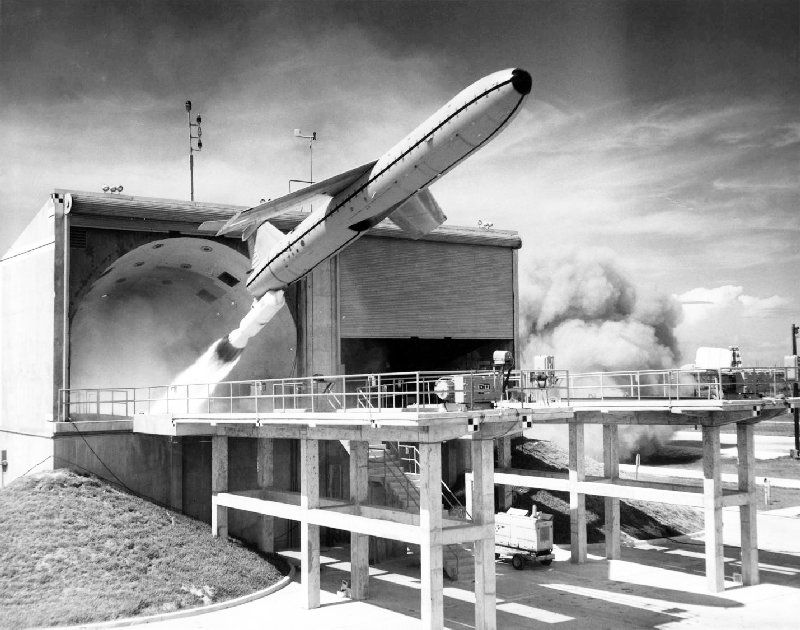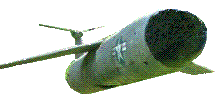
|
In The Beginning... Early History and Evolution
U.S. Air Force Tactical MissilesNow Available On Line at
| ||||||||||||||||||||||||||||||||||||||||||||||||||||||||
|
Beyond the Web Page... The only book devoted exclusively to the Matador and Mace Tactical Missiles. The book reveals the story from the initial idea that became the first U.S. pilotless bomber, through the politically troubled development of the ever evolving deployment methods of the Matador and Mace Tactical Missiles. It covers the Units, Groups, Squadrons and Wing that fielded the missiles. From the United States test sites, Europe, Asia and North Africa nothing is omitted. All phases of the application of these two missiles by the U.S. Air Force (and West German Luftwaffe) are included, from the first tentative launches of the XSSM-A-1 Matador in January 1949, to the tense alert duty of the Cuban Missile Crisis, and the final launch of a MQM13A in May of 1977. The maintenance, logistics and launch, the men, equipment and tactics are all there. |
|
US Air Force Tactical Missiles ©2008 - George Mindling and Robert Bolton | |
|
Inspired by the 38th TMW Website, George Mindling and Robert Bolton co-authored US Air Force Tactical Missiles 1949 - 1969: The Pioneers ©2008, the story of America's first operational missiles, from the Matador to the Mace, from Taiwan, Korea, and Okinawa to Germany, including Lowry, Orlando, Holloman, Santa Rosa Island at Eglin, and even Camp Happiness! | |
|
The First Cruise Missiles
In addition to the Eglin group, a detachment of the Special Weapons Branch, Wright Field, Ohio, arrived at Wendover Field in Utah in 1944 with the mission of evaluating captured & experimental rocket systems, including the JB-2. Testing was at a site just south of Wendover's Technical Site.
Contracts were let for production of 2,000 weapons, designated JB-2, for "Jet Bomb"-2. Powered by One Ford IJ-15-1 770 lbs thrust pulsejet engine which was reversed engineered from the captured German Argus-Schmidt pulsejet in the V-1, the airframe was to be built by Republic Aviation, but sub-contracted the airframe to Willys-Overland. Production of the JB-2 came to an end after the close of the 2nd World War, in September 1945,with 1,385 JB-2s delivered to the USAAF. Test launches continued, both at Wendover and Eglin. On January 26, 1946, Army Air Forces created the First Experimental Guided Missiles Group to develop and test missiles at Eglin Field. In the immediate post-war years, this organization launched and evaluated the JB-2 and performed extensive work with drone aircraft. The U.S. Army Air Force continued development of the JB-2 as Project MX-544, with two versions: one with preset internal guidance and another with radar control. Several launch platforms were developed, including permanent and portable ramps, and mobile launching from beneath the wings of B-17G or B-29 bombers. After World War II, the JB-2 played a significant role in the development of surface-to-surface missile systems. Testing continued from 1944 to 1946 at Eglin Army Air Field, Florida, to improve launch and guidance.
The SS 337 Carbonero, pictured, was the 2nd US Submarine to launch the Loon. The first was the SS 348 Cusk which successfully launched its first Loon on February 12th, 1947, off Point Mugu, California. |
|
After the United States Air Force became a fully independent arm of the National Military Establishment (later renamed to the Department of Defense) on September 18, 1947, research continued with the development of unmanned aircraft and pilotless bombers, including the already available JB-2 and the sub-sonic, 500 mile range XSSM-A-1 which had been specified in December of 1945. The contract for developing the XSSM-A-1 was awarded to the Glenn L. Martin Company of Baltimore, Maryland and was known as the MX-771 project. The XSSM-A-1 would become the B-61 Matador, the U.S. Air Forces first operational missile. The USAF Air Materiel Command reactivated the JB-2 as Project EO-727-12 on 23 April 1948, at Holloman AFB, New Mexico, the former Alamogordo Army Air Field. The JB-2 was used for development of missile guidance control and seeker systems, testing of telemetering and optical tracking facilities, and as a target for new surface-to-air and air-to-air missiles. The JB-2 project used the North American Aviation NATIV (North American Test Instrument Vehicle) Blockhouse and two launch ramps at Holloman: a 400-ft, two-rail ramp on a 3 degree earth-filled slope, and a 40-ft trailer ramp.
Air Force Manual 52-31 artist's depiction of a JB-2 Ramp Launch The earth-filled ramp was scheduled for completion in January 1948. The first firing of a JB-2 at Holloman Air Force Base occurred on 3 May 1948, and the last took place 10 January 1949, after 11 missions. The last JB-2 launch occurred just 10 days before the first launch of the new Martin XB-61 Matador. The JB-2 program was concluded after successful development of a radio guidance system which could launch, turn, circle, and skid-land a JB-2 under the control of an airborne or ground transmitter. There are over twenty five of the remaining JB-2/LTV-N-2 airframes that have been restored by aviation museums around the country, including the US Air Force Museum in Wright Patterson Air Force Base, Ohio. The US Register of Historic Places lists two sites on US Air Force property at Eglin Air Force Base. 8OK246 and 8OK248, both on Santa Rosa Island, that include the wreckage and remnants of 18 JB-2 missiles that crashed in the sand and are still part of the Florida landscape. The airframe of at least one other unlaunched JB-2 is believed to be also buried somewhere in the dunes. | |
JB-2 Ramp at Holloman AFB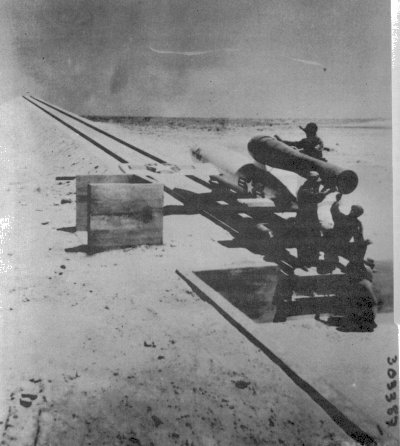
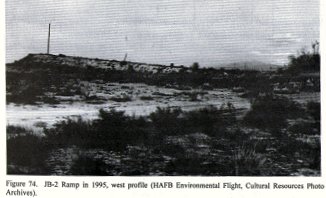 " Figure 74. JB-2 Ramp in 1995, west profile (HAFB Environmental Flight, Cultural Resources Photo Archives). Original 1947 drawings show a 440' long earthen ramp with a concrete loading pit (Figure 75). The ramp ranges in width from 10' at the south end to 80' at the north end and faces 330 degrees. The ramp bed is inclined at a 3 degree slope, starting at the existing ground level (south end) and rising to a height at the north end of approximately 24'. Two parallel, 75 pound ASCE (American Society of Civil Engineers) rails are set 4'11" apart and run for 392'2" along the top. The track sits on 18" tall steel I-beams resting on 77 standard 8" x 1' x 7' wood cross-ties. A bed of 10" thick reinforced concrete was poured over a compacted subgrade between I-beams. The rails were apparently transferred from JB-2 test facilities at Wendover AAF in Utah and used in the construction of this ramp. At the north end of the ramp a concrete stairway leads down to a 20' x 40' concrete pad cut into the ramp. The pad is elevated about 4 feet above the present ground surface with two sets of concrete steps running to the ground. A partially obscured, semisubterranean cable trench runs from beneath this feature southeast to Building 1116. A 5' x 10' concrete pad sits at the north end of the ramp beyond the rails, and 2" x 10" wood planks extend from this feature to a metal tower situated just off the end of the ramp. A wood flume runs from a channel between the end of the rails and this pad to three concrete pads situated below the ramp. A wooden stairway also runs off the west side of the ramp (Mattson and Tagg 1995:38-43)."
"
The JB-2 Ramp retains its original size and shape and maintains historic integrity. Most of the original materials used to construct the earthen ramp are still visible, although some modifications have occurred. Only 105 ft of rail at the south end and a single rail in the center of the ramp remain intact. The remainder has been cut off and removed. The loading pit and north end of the track have been modified with concrete and wood features, and these features are deteriorating and responsible for erosion of the earthen ramp. The addition of these features has not obscured original workmanship, however. They contribute to the ramp’s early Cold War period of significance."
Mattson and Tagg (1995:39).
"Airplanes, Combat and Maintenance Crews and Air Bases", Martyn D. Tagg, Cultural Resources Manager, Wright Patterson AFB
Our Thanks for the use of the JB-2 Loon Launch Ramp photograph from the publication "Airplanes, Combat and Maintenance Crews and Air Bases", Martyn D. Tagg, Cultural Resources Manager, Wright Patterson AFB |
|
"Shortly after takeoff or during take off the JB-2 exploded and the soldier had photos of the wreckage." "The soldier also had several photos of the firing of this JB-2 engine at -58 and -62 degree farenheit and the soldier apparently worked on version 7 of the JB-2 Engine personally." "Ladd field was used for the land lease plane program with Russia during WWII and also was a cold weather testing facility of not only the JB-2 but also several other planes and a helicopter outfitted with tank treads. A very interesting scrapbook which was falling apart and I am selling piecemeal." "You may wish to expand this website to include the Ladd Field experiments." Bob Baillargeon(bobandcharlotteb@msn.com) |
The MX-771 Project
|
The U.S. Army Air Force Air Material Command issued a design standard for a missile that could fly between 175 and 500 miles at speeds of 600 mph, or even supersonic speeds in 1945. The project was called MX-771 and had two parts: A subsonic version numbered the XSSM-A-1 and a supersonic model numbered the XSSM-A-2.
The Glenn L. Martin Co. signed the contract with the US Army Air Force on April 22, 1946 to design and build the missiles stipulated by Project MX-771. The supersonic part of the project was cancelled within the year as it was duplicated by the MX-770 North American Aviation project that became the SM-64 (X-10) Navaho. Testing the new Martin subsonic missile, named the Matador, began at Holloman AFB in 1948. The first Matador, model XSSM-A-1, was successfully launched at the White Sands Missile Range on 20 January 1949, not far from the launch ramp used by the JB-2 program which concluded only 10 days earlier. Matador flight testing was moved to Cape Canaveral, Florida, in 1950, and the YB-61 Matador had the distinction of being the first missile launched at the Cape to utilize the Atlantic Missile Tracking Range. Redesignated to its production identifier, the B-61, the experimental version was labeled XB-61, the prototype became the YB-61. All prefixes to the B designator were dropped once the missile had been accepted by the US Air Force. The TM, or Tactical Missile designator was not applied until 1955. At that time, the original B-61 was redesignated as the TM-61A as two newer Matador models were in development: the TM-61B, which became the TM-76A Mace, and the TM-61C, the last operational Matador phased out in 1962. A YB-61 Prototype, one of the original 18 "Red" Matadors, sits on its Zero Length Launcher, at Patrick Air Force Base, Florida. This USAF/Glenn L. Martin Photo was used as the cover of the "Martin Star," the Glenn L. Martin Company magazine on its November, 1951 issue. |
|
Notice the flat mid-fuselage mounting of the wings and the conventional horizontal stabilizer with traditional control elevators, and the closable door panels over the booster rocket mounting point. The tail number appears to be GM 546 (GM was used before before the standard year-of-contract tail numbering system was initiated), the 3rd Matador of 280 launched from the Cape and Patrick AFB by both the Martin Co.and Air Force test and operational units. |
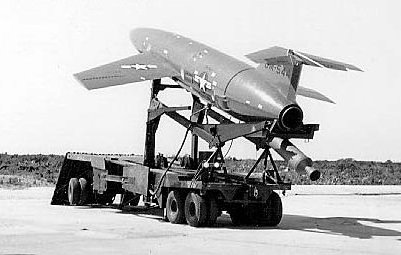 In this photo of XB-61 GM-544, the first Matador launched from Cape Canaveral on 20 June 1951, the elevators on the horizontal stabilizer are readily apparent. The left finger spoilers (There is a set mounted in each wing) are seen in the far extreme reaches of the wingspan. Later versions moved the spoilers in to about mid-wing position and made more parallel to the leading edge of the wing. |
The length has been stretched and the diameter of the fuselage has been made more consistant with the 54 inch requirement of the J-33 A-31 (later A-37 and A-41) jet engine. The upper mid-fuselage breather doors were a trade mark of all the Martin series winged missiles. A TM-76 Mace "B" was filmed headed downrange from Pad 21 at the Cape with the red plastic dust covers that were normally used only while the missile was in storage or in transit, firmly in place, trailing the red "Remove before flight" streamers behind. |
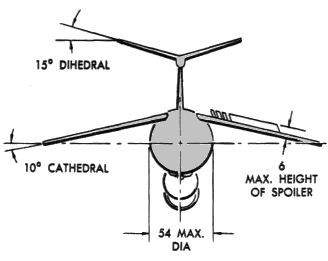
|
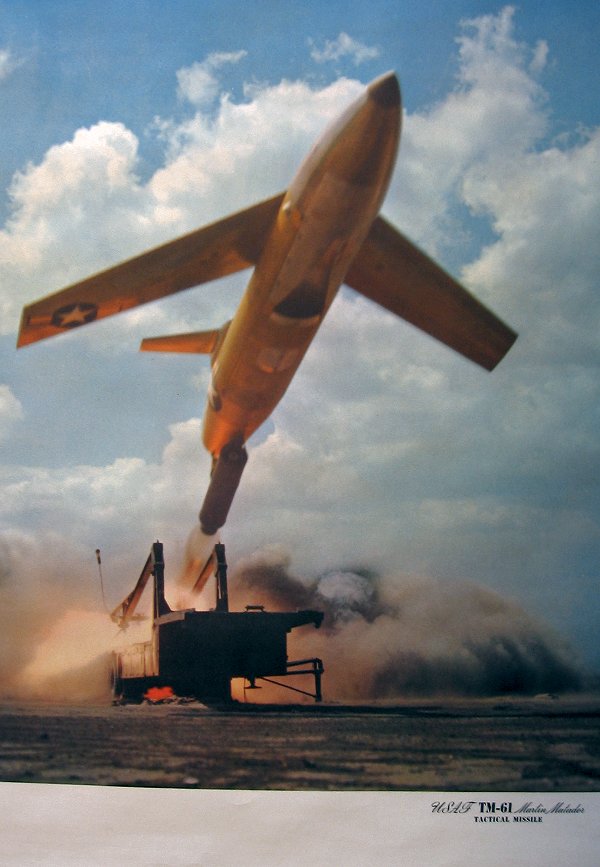
Poster of B-61 (TM-61) Matador launch courtesy of Alan Meade (almede@verizon.net)
|
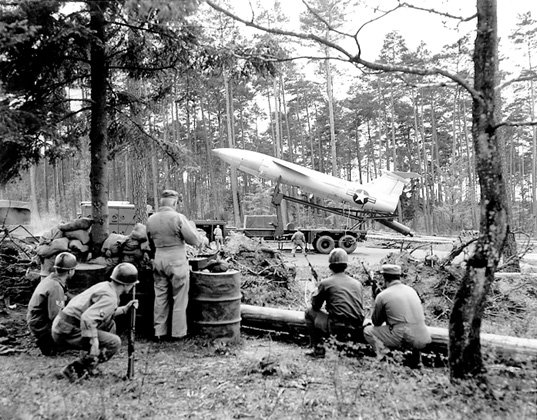
An operational B-61A Matador on alert at Hahn Air Base sometime in the Fifties in this undated and uncredited USAF Museum Photo.
|
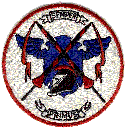
For a closer look at a combat ready Matador site, take a look at the 71st TMS "A" pad at Steinborn, Germany
|
|
|
Able 51/ZEL Site: Buildings 1440 and 1442By 1957, the major guided missile and experimental test programs of the late 1940s and early 1950s had completed their ground launch testing, with the exception of the Aerobee. The focus at HAFB during the late 1950s was on air-launched guided missiles, target drones, and components testing planned for the High Speed Test Track (HSTT). The only ground-launched vehicles tested during this time were the drone versions of the Matador and development testing of the new Mace. Flight testing included two launches in late 1957 and early 1958 of the TM-76A Mace (renumbered several months earlier from its original designation of TM-61B Matador) that were targeted to Wendover Gunnery range in Utah, almost 700 miles away! Original flight tests were with the ATRAN guided TM-76A, including development of the Rapid Fire Multiple Launch concept, and support of Detachment 1, 4504th Missile Training Wing out of Orlando AFB that was involved in training crews for deployment to Germany. The first 6 launches of the hardsite, inertially guided, longe range TM-76B were launched from a sheltered zero length “hardsite” called the ZEL (ZEro Length) site, Able 51, before being moved to Cape Canaveral in 1959 for final testing and crew training. Two intact buildings, 1440 and 1442, and numerous concrete pads remain at this launch facility at Holloman.
[During the 1950s, before ICBMs were developed, the principal Cold War threat was from manned bombers. Fighter aircraft, which needed long runways for take-off, were the best counter for this threat. If an enemy bomber broke through the U.S. defenses, it could wipe out the fighter force and runways. In addition, Allied forces in Germany needed the ability to launch fighters from unprepared airfields without long, highly visible runways. The U.S. began developing the ZEL launcher in response to these threats and needs. After unmanned tests, the USAF launched its first successful manned aircraft: F-84 from a mobile launcher at Edwards AFB in 1953. The mobile launchers were considered strategically sound because they could be moved to different areas and thus would be hard for the enemy to track. (Mattson and Tagg 1995:57; Smithsonian Institution 1995).] [The first simulated atomic blast proof shelter was constructed on HAFB. The launch facility, Building 1442, was constructed to withstand the overpressure resulting from an atomic bomb explosion. The hardsite would protect the fighter parked in the structure, and a ZEL launcher would catapult the aircraft into the air to meet the next wave of enemy bombers without need of a runway. The ZEL launcher was similar in function to those used on Navy aircraft carriers. The launcher elevated the fighter’s nose to a 15 degree angle and the thrust of a rocket motor attached to the plane’s fuselage, combined with the thrust from the fighter’s jet engine, propelled the munition-laden aircraft into the air (Mattson and Tagg 1995:57; Smithsonian Institution 1995).]
Figure 78. Mace missile (TM-76A) launch from Able 51/ZEL site (Building 1442), 12 May 1959 (HAFB Environmental Flight, Cultural Resources Photo Archives). A TM-76A is launched from the sheltered Zero Length launcher. Notice the bulge under the aft fuselage to house the airbags for missile recovery. White sands also had special dogs, called "the Missile Dogs" to find errant birds that failed to follow their planned flight path. The ZEL facility (The building 1442 covered site: all Matadors and Maces were launched from Zero Length Launchers, regardless of launch location) was used primarily for testing the Mace "B" missile, although the Matador missile and the BQM-34A Firebee drone were also launched from mobile launchers tied down to concrete pads at the site (Figure 79). [In August 1959, a manned F-100 fighter with a 130,000 pound thrust Astrodyne solid fuel rocket booster was launched from Building 1442 using the ZEL launcher. The combination of the booster rocket motor and jet engine thrust boosted the F-100 to a speed of 300 mph and an altitude of 350 ft in just six seconds. Another F-100 was successfully launched during a night test, but then testing was discontinued at Able 51. The ZEL program continued, though, with mobile launches of F-104s by the German Air Force in Germany. ZEL-launched fighters never became an operational program in the U.S. The need for such launchers became obsolete with the development of long range bombers and ICBMs that could be launched from the U.S., and nuclear submarines that could maneuver within firing distance of the U.S.S.R.]
The Matador was the first USAF missile to reach operational status. It was a high altitude, high supersonic, (Webmaster´s note: only in terminal dive after the wings had been separated by primercord) surface-to-surface missile which had been tested at HAFB since 1949 and became operational in 1954 with the deployment of the 1st Pilotless Bomber Squadron to Bitburg Air Base, Germany. The Matador had various project designations including MX-771, XB (experimental bomber)-61, TM-61, and Martin B-61. The two operational versions of the Matador (TM-61A and the TM-61C) were 39´9" long, weighed 12,000 to 13,000 pounds, and had a wing span of 28´10" . They were powered by an Allison J-33-A37 jet engine that produced 4,600 pounds of thrust. A single Thiokol booter, giving 50,000 pounds of thrust, was used to launch the missile. Matadors were launched from mobile launchers tethered to concrete pads just north of Building 1440, the launch control blockhouse. The transporter could not be used as a launcher, so the missile was transferred to a ZEL launcher that resembled the flatbed trailer of a tractor trailer. The launcher was elevated to give a 15 degree positive angle of attack for launch. There is photographic evidence that the Matador was launched from the MTSA.
|
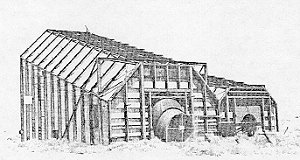
(HAFB Environmental Flight, Cultural Resources Photo Archives)
|
|
Mace "A" recovery photo by Glenn L. Martin, Co. |
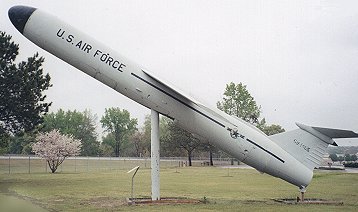
TM-76 Mace at the Museum of Aviation, Robins AFB, Georgia, Photo by George Mindling myakka@embarqmail.com |
A51 and the Mace MissileThe Hardsite Shelter (Building 1442) includes two launch bays, the larger for F-100 fighter aircraft and the smaller for Mace missile launch (Figure 29). The structural exoskeleton is composed of 13 I-beam frame segments of progressively increasing size. Each segment is anchored to the massive concrete floor slab, and segments are joined by more I-beam framing at the principal corners at the top of the vertical walls and along the top of the angled flat roof. The cross-sectional shape of the two bays, which share a common internal wall, is rectangular with deeply chamfered corners. Both bays are reinforced at the rear by additional angular I-beam bracing to withstand launch blast. Two large, circular, frame-deflection tubes exit the rear walls and apparently angled to the sides. Both have been partially dismantled, and remaining pieces lie nearby. Walls consist of corrugated steel with thick insulation held in place by expanded mesh covering interior surfaces, probably for noise suppression. Launch catapults have been removed, but parts remain outside the structure.
Building 1442: The ZEL Shelter According to Wayne Mattson (personal communication 1994), the Hardsite Shelter (Plates 19 and 20) was originally designed to counter the threat posed by nuclear attack on conventional runway aircraft launch facilities. The building, made from plate steel supported within an exoskeleton of steel I-beam framing, was designed to withstand nuclear overpressures, protecting aircraft and missile systems and providing zero-length catapult launch at an upward angle of about 15 degrees. After test flights by manned F-84 fighter aircraft and a series of dummy launches (beginning 15 May 1959) by North American Aviation engineers, the first manned F-100 fighter aircraft, boosted by a 130,000-lb thrust Astrodyne solid-fuel rocket, was successfully launched on 19 August 1959. Additional manned flights continued until 26 August. The first Mace (a TM-76A) launched from the smaller bay of the hardsite (as in Plate 21) took place on 12 May 1959. REACH FOR THE SKY THE MILITARY ARCHITECTURAL LEGACY OF HOLLOMAN AIR FORCE BASE, NEW MEXICO, 1941 TO 1961 by Peter L. Eidenbach and Richard L. Wessel [AUTHOR'S NOTE: "Reach For The Sky" is not an authorized USAF document as it was never accepted by by Holloman AFB as a final document. While included in this page for reference, historical errors have been found in this document and should be treated accordingly.] My thanks to the Cultural Resources Manager, Wright Patterson AFB, for the correction. |
Test and Development | |||
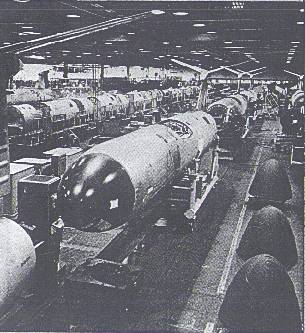
Serial Numbers known to date:
Our Thanks for the incredible work done by Joe Baugher. Check his incredible compilation of serial numbers at:
|
| ||
| December 27th, 2003, 08:49 PM
Some of the guys here may remember conversations a while back, where Dockeen, Prop... and I were talking about missile launches from Santa Rosa Island, Florida in the late '60s.
I stumbled across this shot while websurfing tonight, depicting an MQM-13A Mace (57-2446) launch from Site A-15 on the island. The picture, taken from a rickety wooden tower in the dunes, due east of the pad, shows our Mace (an ex-nuclear missile, now a faded target drone,) roaring off with the then functioning BOMARC launchers in the background. This was to have been a St. Patrick's Day launch, and the Colonel's secretary, "Missy" Fitzpatrick, pressed us into racing out to the pad and spray-bombing a Shamrock for luck... using zinc-chromate. (I seem to recall it weathered, and flew later.) The neat thing about this is that I took the picture! That is a shock to see your past by accident. This was our unit Christmas card that year, and A2C Denny Keasling, then my roomate, must have sent the card to the webmaster. Small world! :lol: Paul F. Dion
|
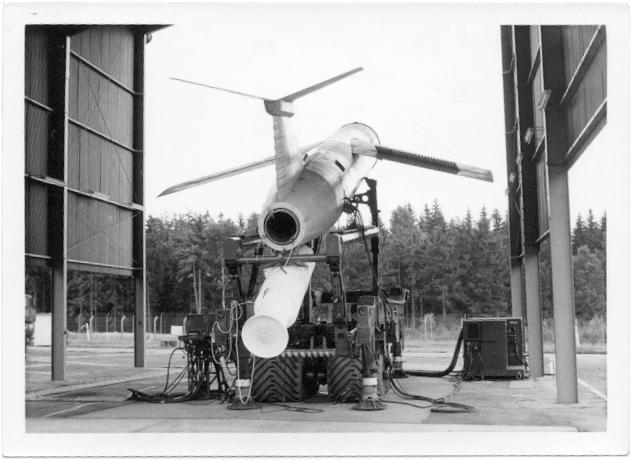
|
|
An operational TM-76A of the 89th Tactical Missile Squadron on alert at Photo coutesy of Charles Martin, TAC Missileers Association |
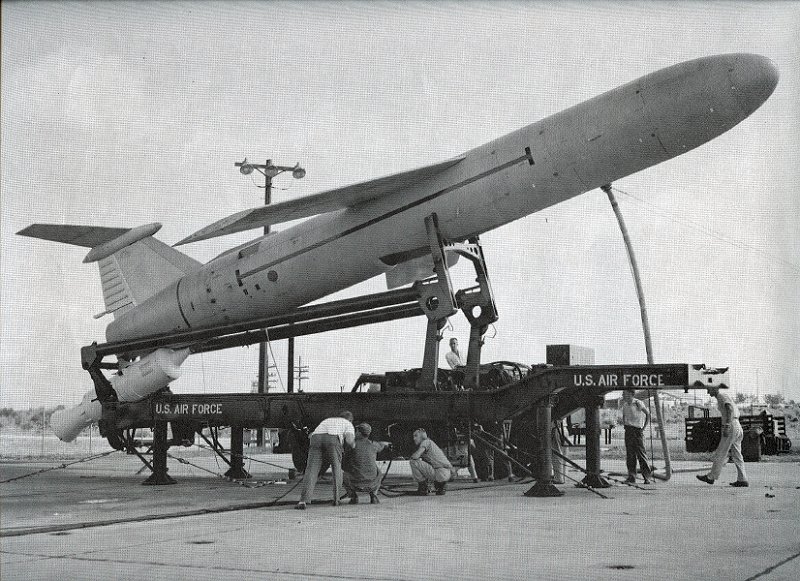 | |
|
A TM-76B during pre-launch check at Cape Canaveral while mounted on a TM-76A translauncher during Research and Development testing. Research continues on the guidance system used and how the bird was launched. Notice the ARW-59 Command Guidance antennae mounted on bottom the vertical stabilizer, and the single air conditioning hose entering the warhead section but not the nose A/C as in operational missiles. photo: Office of Information Air Force Missile Test Center, Cape Canaveral - Atlantic Missile Range Courtesy of Robert Bolton (olliesnapper@gmail.com) | |
|
References:
|
|
Special Thanks to Martyn Tagg
|
[ Sembach Air Base | Hahn Air Base | Bitburg Air Base ]
[ 498th TMG at Kadena
| Lowry Technical Training Center | 4504th MTW at Orlando ]
[ The Missiles: History | The Missiles: Spotter's Guide | The Missiles: Guidance & Flight Controls ]
[ MM-1 Teracruzer | Collectibles & Patches | Contact Us ]
This page is in no way sponsored or endorsed by the United States Air Force.
|
Web Page Design and Development by
George Mindling - Port Charlotte, Florida
©George Mindling - 2003-2006 All Rights Reserved


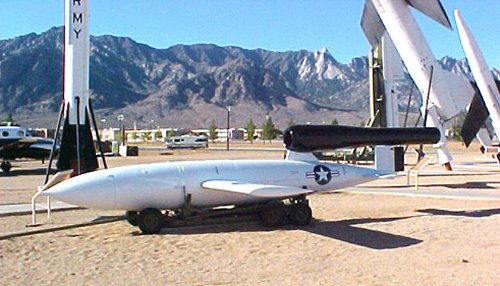
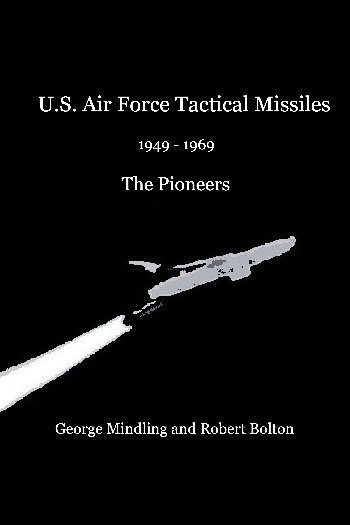
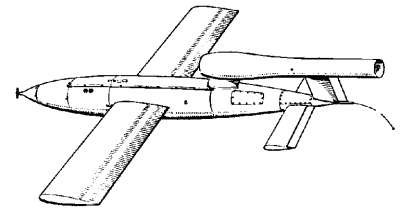 In July 1944, three weeks after German V-1 "Buzz Bombs" first struck England on June 12th and 13th, American engineers fired a working copy of the German V-1 pulse-jet engine, "reverse-engineered" from crashed German V-1 buzzbombs that were flown back to Wright Field, Ohio for analysis. The reverse engineering, called at the time a "Chinese Copy" provided the design of America's first mass-produced guided missile, the JB-2. The first unmanned guided missile in America's arsenal. The first launch of a JB-2 took place at Eglin Army Air Field in Florida in October 1944.
In July 1944, three weeks after German V-1 "Buzz Bombs" first struck England on June 12th and 13th, American engineers fired a working copy of the German V-1 pulse-jet engine, "reverse-engineered" from crashed German V-1 buzzbombs that were flown back to Wright Field, Ohio for analysis. The reverse engineering, called at the time a "Chinese Copy" provided the design of America's first mass-produced guided missile, the JB-2. The first unmanned guided missile in America's arsenal. The first launch of a JB-2 took place at Eglin Army Air Field in Florida in October 1944.
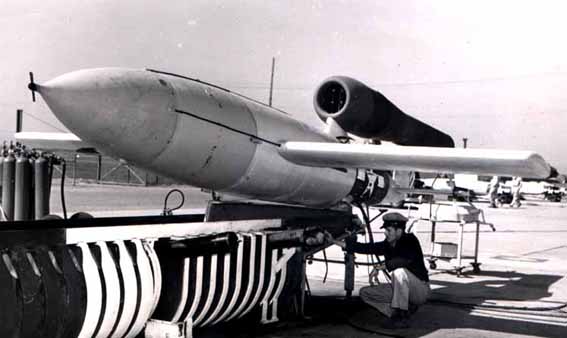
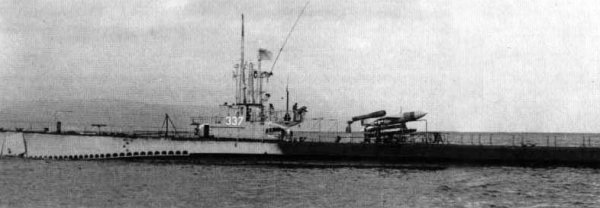 The U.S. Navy developed a submarine-launched version, KUW-1 Loon, later called LTV-N-2, which were carried on the aft deck in watertight containers.
The U.S. Navy developed a submarine-launched version, KUW-1 Loon, later called LTV-N-2, which were carried on the aft deck in watertight containers.

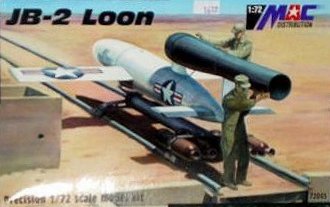
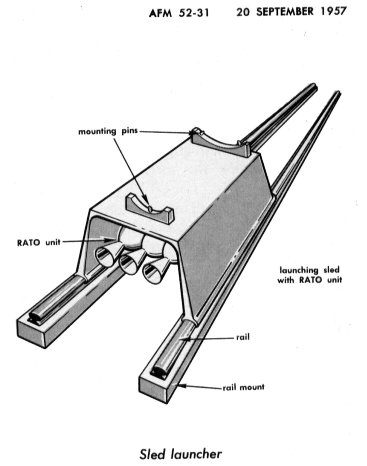 "
The loading pit, situated at the south end of the ramp, is rectangular with a flared apron at the south end. The pit is 20 feet x 16 feet x 3 feet 3" deep with 8" thick concrete walls and the apron is 20 feet long and 34 feet wide at its widest point. The pit was apparently once open to the south but has been enclosed with a concrete wall; a 6'4" x 5'4" entryway is now situated in the center of this wall. The height of the pit walls has also been extended 4 feet, encasing the southern ends of the rails. A “reinforced concrete structure” is shown just west of the south end of the track by the loading pit (CE File IE 232). A 1948 photograph verifies this feature as being U-shaped (see Figure 64). An identical structure is now located on the east side of the track. It has 8" thick concrete walls and floor and inside dimensions of 6´ x 4´ x 4´ deep (Mattson and Tagg 1995:39-43). The original architectural drawings, labeled as-built, were provided by the War Department, U.S. Army Corps of Engineers, Office of the District Engineer (Albuquerque, New Mexico). The builder is unknown."
"
The loading pit, situated at the south end of the ramp, is rectangular with a flared apron at the south end. The pit is 20 feet x 16 feet x 3 feet 3" deep with 8" thick concrete walls and the apron is 20 feet long and 34 feet wide at its widest point. The pit was apparently once open to the south but has been enclosed with a concrete wall; a 6'4" x 5'4" entryway is now situated in the center of this wall. The height of the pit walls has also been extended 4 feet, encasing the southern ends of the rails. A “reinforced concrete structure” is shown just west of the south end of the track by the loading pit (CE File IE 232). A 1948 photograph verifies this feature as being U-shaped (see Figure 64). An identical structure is now located on the east side of the track. It has 8" thick concrete walls and floor and inside dimensions of 6´ x 4´ x 4´ deep (Mattson and Tagg 1995:39-43). The original architectural drawings, labeled as-built, were provided by the War Department, U.S. Army Corps of Engineers, Office of the District Engineer (Albuquerque, New Mexico). The builder is unknown."
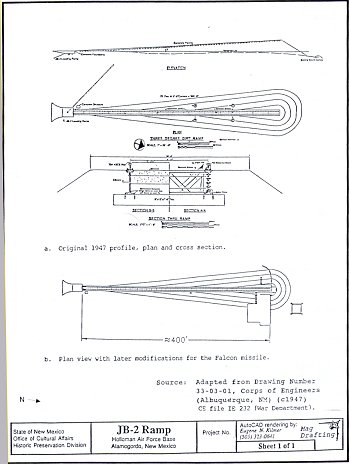 Figure 75. JB-2 Ramp; profile, plan view, and cross section, ca. 1947, and plan view with later modifications as it appeared in 1996.
a launching area on a 1957 base map and locally known as the MTSA (see Figure 12). Contemporary facilities and features such as Building 1116, which was used as the observation shelter for the JB-2 and Falcon missile programs, and numerous concrete pads and features still remain in the vicinity. The structure was used for its original purpose until missile testing was no longer conducted at the MTSA in the late 1950s. Since that time it has been abandoned. The structure continues to exhibit its historic character as a test vehicle launch ramp and retains its integrity of association with early Cold War missile testing"
Figure 75. JB-2 Ramp; profile, plan view, and cross section, ca. 1947, and plan view with later modifications as it appeared in 1996.
a launching area on a 1957 base map and locally known as the MTSA (see Figure 12). Contemporary facilities and features such as Building 1116, which was used as the observation shelter for the JB-2 and Falcon missile programs, and numerous concrete pads and features still remain in the vicinity. The structure was used for its original purpose until missile testing was no longer conducted at the MTSA in the late 1950s. Since that time it has been abandoned. The structure continues to exhibit its historic character as a test vehicle launch ramp and retains its integrity of association with early Cold War missile testing"
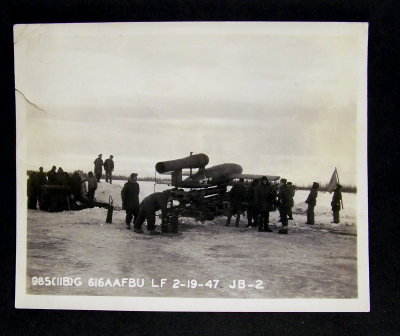 "I am an eBay seller and picked up the scrapbook of a soldier in the 321st Squadron Armament group who was part of the group who tested the JB-2 at Ladd Field in 1946-47. Please see attached USAF photo of JB-2 test plane (sic)."
"I am an eBay seller and picked up the scrapbook of a soldier in the 321st Squadron Armament group who was part of the group who tested the JB-2 at Ladd Field in 1946-47. Please see attached USAF photo of JB-2 test plane (sic)."
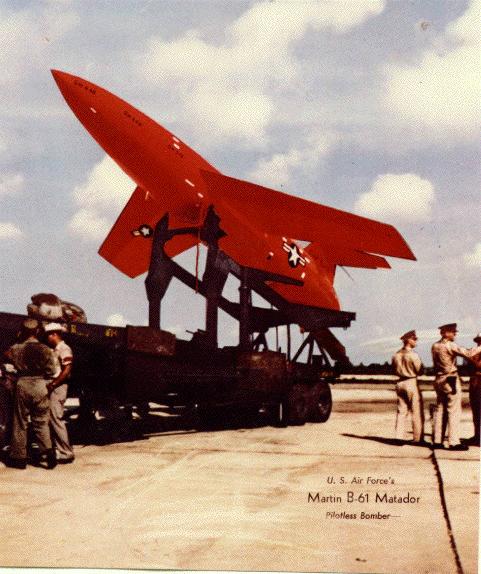
_01.jpg) A XB-61 heads downrange from Cape Canaveral (Notice the old lighthouse) in this undated USAF photo.
A XB-61 heads downrange from Cape Canaveral (Notice the old lighthouse) in this undated USAF photo.
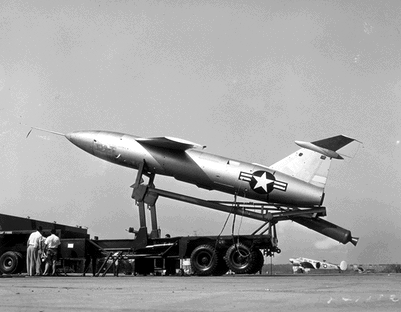 In this Martin photo of a B-61A being prepared for launch, notice the wings have been moved to the top of the fuselage with 10 degrees negative dihedral (anhedral or cathedral) and the horizontal stabilizer has been modified to the "flying wing" style stabilizer, called a Variable Incidence Horizontal Stabilizer, and given 15 degrees dihedral. The new head on profile was instantly recognizable and became the trademark of both the Matador and Mace missiles. The closeable doors for the RATO booster bottle were also dropped.
In this Martin photo of a B-61A being prepared for launch, notice the wings have been moved to the top of the fuselage with 10 degrees negative dihedral (anhedral or cathedral) and the horizontal stabilizer has been modified to the "flying wing" style stabilizer, called a Variable Incidence Horizontal Stabilizer, and given 15 degrees dihedral. The new head on profile was instantly recognizable and became the trademark of both the Matador and Mace missiles. The closeable doors for the RATO booster bottle were also dropped.
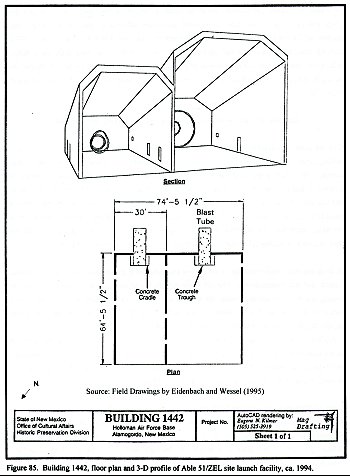
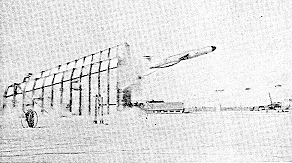
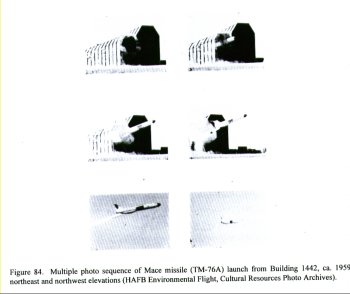
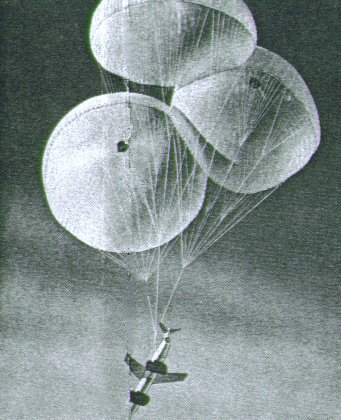
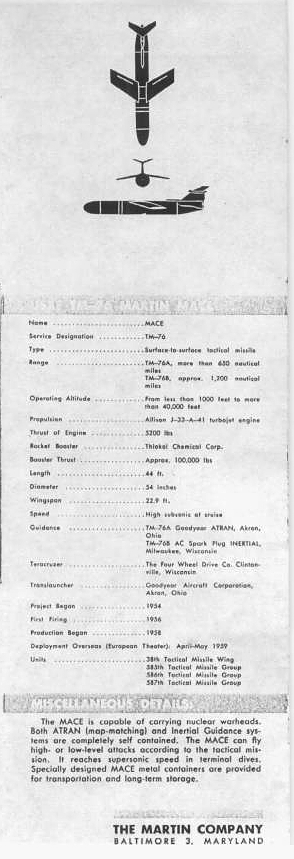

 4504th Missile Training Wing
4504th Missile Training Wing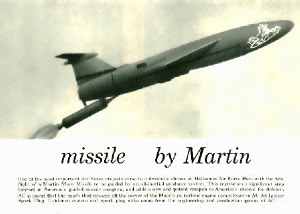

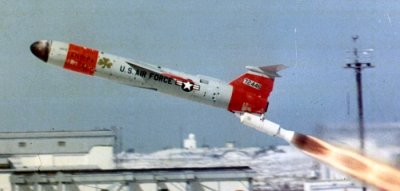
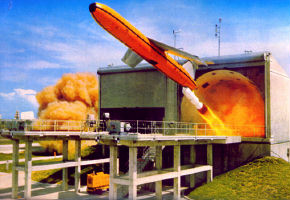 A color USAF photograph of a TM-76B launch at Cape Canaveral using one of the two hard sites built to test the hard site launch characteristics, and the same photo below, reversed in black and white. Notice the location on the weather vane and the lights on top of the launch tubes in both photos.
A color USAF photograph of a TM-76B launch at Cape Canaveral using one of the two hard sites built to test the hard site launch characteristics, and the same photo below, reversed in black and white. Notice the location on the weather vane and the lights on top of the launch tubes in both photos.
